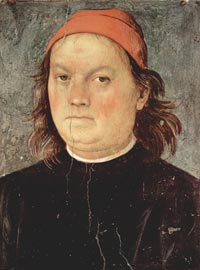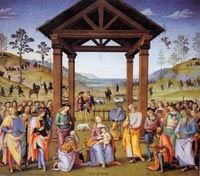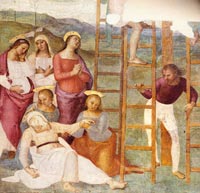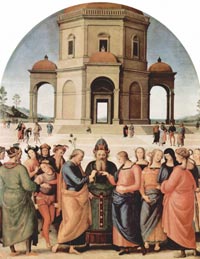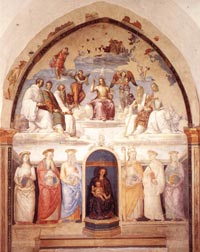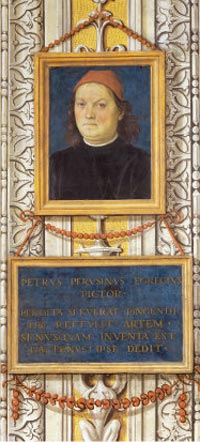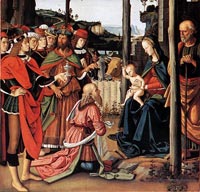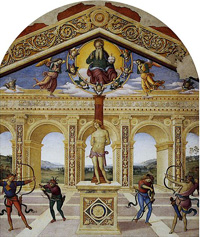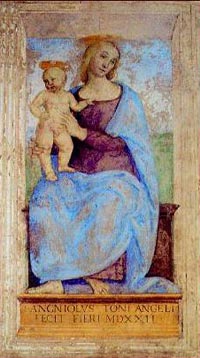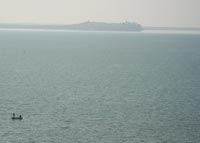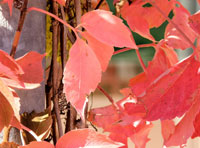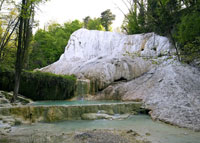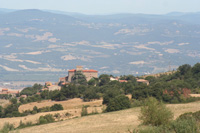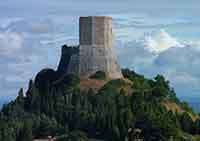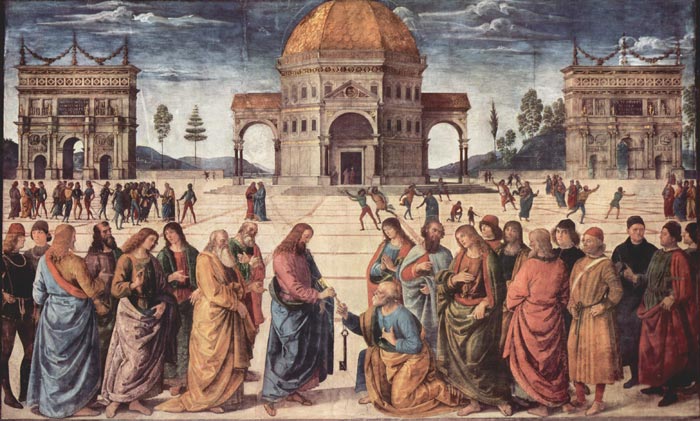 |
|
Il Perugino, Christ Handing the Keys to St Peter, Cappella Sistina, Vatican, Rome |
|
Pietro Perugino (born Pietro di Cristoforo Vannucci) |
| Italian painter and draughtsman, the greatest painter of the Umbrian school. He was baptized Piero di Cristoforo Vannucci, but history knows him as Il Perugino, the man from Perugia. Although he is now known mainly as the teacher of Raphael, he made a significant contribution to the development of painting from the style of the Early Renaissance to the High Renaissance. For a brief moment, he was the most successful painter in Italy. Pietro Vannucci gets his nickname Il Perugino from the Florentines in January of 1501 when he opened his own atelier in Perugia. He was active in Perugia, Florence and Rome in the late 15th century and early 16th. Although he is now known mainly as the teacher of Raphael, he made a significant contribution to the development of painting from the style of the Early Renaissance to the High Renaissance. He studied under Fiorenzo di Lorenzo, assisted Piero della Francesca at Arezzo, and in the early 1470s was a fellow pupil of Leonardo da Vinci and Lorenzo di Credi in Verrocchio's studio in Florence. He worked in Verrocchio's workshop (1470-72) and was influenced by Piero della Francesca and Flemish artists, uniting the clear lines of the former with the use of light of the latter. He worked a great deal in Umbria, Tuscany and Marche, though his most important commissions came from the papal court after his arrival in Rome in 1478. In 1481, Pope Sixtus IV summoned Perugino to Rome to participate in the most important commission of the late 15th centurythe frescoes on the Sistine Chapel walls. In 1489 Perugino painted his masterpiece, the Giving of the Keys to St. Peter in the Sistine Chapel: a work which opened the path for Raphael, who learned much from his balanced composition with its harmonic relationship between figure and landscape and his preference for brilliant colours. The fame of the Sistine fresco was more or less enough to maintain his prestige for the rest of his life. The only real exception of quality was the Crucifix in Santa Maria Maddalena dei Pazzi in Florence (1493-95). The influence of his friend Luca Signorelli strengthened his draughtsmanship, that of Flemings like Hans Memling suggested the landscape background for his portraits as well as their general composition, and to the persistence of Piero's influence is due the use of architectural and landscape settings for his figure compositions. The Pietà (Florence, Accademia) set centrally in a receding arcade, and above all the Cruxifixion with Saints (Florence, Santa Maria Maddalena dei Pazzi), a fresco of 1496 with an extensive landscape linking the three apparent divisions of the wall, are perfect examples of his quiet, pietistic art, with gentle, rather sentimental figures with drooping postures, tip-tilted heads, and mild rounded faces - a type he repeated all his life with, in his later years, dull and routine repetitiveness. From approximately 1490 to 1500, Perugino was at his most productive and at the artistic summit of his career. Among the finest of his works executed during this time are the Vision of St. Bernard, the Madonna and Saints, the Pietà, and the fresco of the Crucifixion for the Florentine convent of Sta. Maria Maddalena dei Pazzi. These works are characterized by ample sculptural figures gracefully posed in simple Renaissance architectural settings, which act as a frame to the images and the narrative. Perugino's art declined in his later years, and c. 1505 he left the highly critical Florentine art scene to work in Umbria. In 1508 he made a brief comeback by painting roundels on the ceiling of the Stanza dell'Incendio in the Vatican. The commission for the wall frescoes went to his pupil Raphael, who had already proved himself the greater artist. From c. 1500 to c. 1504 Raphael was a pupil in his shop and may have helped with the fresco cycle in the Sala del Cambio at Perugia, Perugino's largest work in fresco. Raphael's own early work in San Severo at Perugia was later - after his death in 1520 - completed by his master. In 1506 Perugino retired to Perugia, since his style was now hopelessly outmoded in Florence, where, however, it had served to counter-balance the confusion of late Quattrocento style. It was to be the herald of the High Renaissance. Perugino's last frescoes were painted for the church of the Madonna delle Lacrime in Trevi (1521), the monastery of Sant'Agnese in Perugia, and in 1522 for the church of Castello di Fortignano. Both series have disappeared from their places, the second being now in the Victoria and Albert Museum. In 1524 Perugino was still at Fontignano, a frazione near Lake Trasimeno in Perugia, when he died of the the plague. |
||
Rome, Sistine Chapel
|
||
The wall paintings of the Sistine Chapel are among the most important examples of the type of painting developed in Florence in the later fifteenth century. The five artists brought to Rome to execute them came from various different art centres: Botticelli, Ghirlandaio and Rosselli from Florence, Perugino from Umbria, Signorelli from Cortona. In 1479 Perugino was summoned to Rome by Pope Sixtus IV to help decorate the Sistine Chapel. He is recorded in the 1481 contract for the frescoes in the Sistine Chapel (along with Sandro Botticelli, Domenico Ghirlandaio and Cosimo Rosselli), where his Christ Handing the Keys to St Peter demonstrates his qualities of simplicity, order and clearly articulated composition. He seems to have been the leader of the team. Some of his work in the Sistine Chapel was destroyed to make room for Michelangelo's Last Judgment. Likely in charge of the entire project of the fresco decoration on the walls of the Sistine Chapel, Pietro Perugino retained for himself not only representations on the altar wall (which eventually were replaced by Michelangelo's Last Judgment) but also other significant scenes, such as Christ Handing the Keys to St Peter, a most fitting subject for Pope Sixtus' chapel. The fresco is located in the fifth compartment on the north wall. |
||
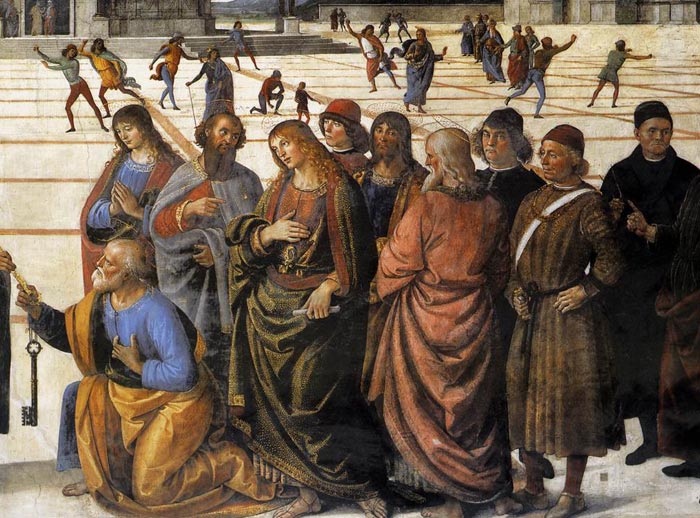 |
||
Perugino's portrait and that of the architect are included in this scene, at a respectful remove from the real dignitaries. The fifth figure from the right in this grouping is a self-portrait. The man holding a square to the right is thought to be a portrait of the architect of the Sistine Chapel. [read more | Perugino in the Sistine Chapel] |
||
Città della Pieve is a charming medieval town, located on the border between Tuscany and Lazio. Città della Pieve was the birthplace of Perugino. Several of his masterpieces are still present in the town, such as the famous Adoration of the Magi (1504) in the Oratory of Santa Maria dei Bianchi, the Madonna in Glory and Saints and the Baptism of Christ in the Duomo.
|
|||
| The Adoration of the Magi (1504), Oratory of Santa Maria dei Bianchi
The story is depicted as a big knightly procession lost in the vastness of one of the largest landscapes created by Perugino. Here is a recognisable, though idealised, the view from Città della Pieve toward Lake Trasimeno and the Valdichiana. |
|
||
At the beginning of 1504 the Mayor of the Brotherhood "Virgin's Disciplined", who were called the Whites because of the colour of their dothes, consulted Perugino about the decoration of the altar of their Oratory. Their initial request got lost together with the archives of the Brotherhood, but fortunately the painter's autograph answer was preserved: it was discovered in 1835 inside a tin tube buried at the bottom of the wall. On 20 February 1504 Perugino wrote from Perugia that the total cost of the work he was asked for amounted to 200 ducats but "he being a villager" was disposed to content himself with half of that sum, one forth immediately and the rest in three yearly installments. The brothers evidently hadn't even this amount of money and tried to haggle about the price. On 1 March Perugino sent a second letter from Perugia in which he granted a further discount of 25 ducats if only they would send him a mule so that he could move to Castel della Pieve and start painting. The negotiation soon found a solution, as shown by the date 1504 which can be seen in the fresco in the middle of the meadow at the foot of the holy family. Nevertheless, the brothers had difficulty in meting the expiration dates of the installments. Three years later, on 29 March 1507, in exchange for the final balance of 25 ducats, Perugino accepted the ownership of a house in the village which had been given to the brotherhood by the late Mariano di Giovanni Cend with the clause that it would be used "for ornament of the paintings" created in the houses of the Brotherhood. Though it was completed very quickly, the work is completely autograph - in the letter of 1 March 1504 no mention is made to somebody having helped him - and it inaugurates the "impressionist" manner of the late Perugino, characterized by an extreme parsimony of means and by his predilection for very dear colours giving the impression of a pastel. |
|||
In a small church outside the city walls, one can admire another important fresco, largely destroyed during the seventeenth century renovation of the church.
The small original gothic, now barock, Chiesa di Santa Maria dei Servi i fuori Porta Romana is decorated with Perugino's great fresco la Deposizione della Croce. The Deposition of the Cross dates from 1517 and is perhaps the most surprising work by the artist prior to his death. |
|||
|
|||
Perugia |
|||
From 1496 to 1498 Perugino worked on the great altarpiece, The Ascension, for San Pietro of Perugia. He also undertook the decoration of the audience hall of the Cambio in Perugia, consisting of allegorical figures and two sacred subjects, Nativity and Transfiguration. Perugino returned from Florence to Perugia, where his Florentine training showed in the Adoration of the Magi for the church of Santa Maria dei Servi (ca 1476). From c. 1500 to c. 1504 Raphael was a pupil in his shop and may have helped with the fresco cycle in the Sala del Cambio at Perugia, Perugino's largest (but not best) work in fresco. Raphael's own early work in San Severo at Perugia was later - after his death in 1520 - completed by his master. In 1506 Perugino retired to Perugia, since his style was now hopelessly outmoded in Florence, where, however, it had served to counter-balance the confusion of late Quattrocento style. |
|||
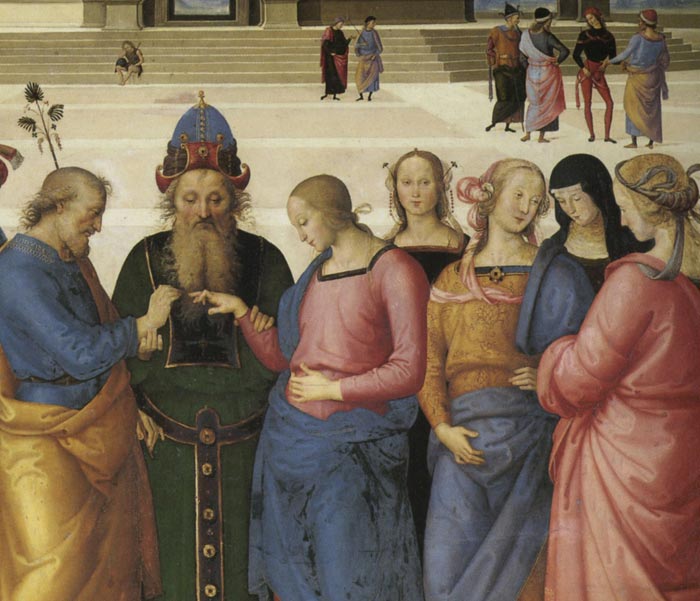 |
|||
Perugino, Marriage of the Virgin (detail), (1501-1504), Musée des Beaux-Arts, Caen |
|||
Perugino painted his Marriage of the Virgin for a chapel in the cathedral in Perugia, which was completed in 1489, and in which the Virgin's engagement ring was kept. This valuable relic had been stolen from a church in Chiusi in 1478 and had only recently been retrieved, so it is not surprising that it is in the centre of this picture. Pinturicchio had been originally been commissioned to complete of the work, but when he failed Perugino was called on. He finished the work around 1500-1504, probably after several periods of stasis. |
|||
Martyrdom of San Sebastiano, which was recently restored, is located in the San Sebastiano church. San Sebastiano is a small, romantic and extremely beautiful church right outside the walls. |
|||
Perugia - Cappella di San Severo (Raffaello e Perugino) |
|||
| The Chiesa di San Severo in Piazza San Severo retains a fresco painted by Raphael and Perugino. The fresco was part of a larger composition (height 445 cm). Two inscriptions indicate the contribution of Raphael. After his father died, Raphael went to the town of Perugia to be an apprentice of the painter Pietro Perugino. Raphael picked the usage of shade and light, and with Perugino, Raphael learned what he is very famous for: depth and perspective. Raphael studied under Perugino. Raphael executed at the San Severino chapel in Perugia, a fresco of which he painted only the upper part (it was completed in 1521 by the aged Perugino). This fresco, which was important in as much as it contained the germ of the "Disputa", merely reproduces the arrangement of Fra Bartolommeo's "Last Judgment". To him Raphael owes the methods by which he produced the Virgins of the third group, in which the Madonna appears at full length in a landscape with the Infant and the young St. John. The sublime trio in such compositions as "La Belle Jardiniere" (Louvre, 1507), the "Madonna of the Meadow" (Vienna), or the "Madonna of the Goldfinch" (Uffizi, Florence) is an idea directly derived from the teachings of the artist-monk. Here Raphael detaches himself from the external symmetry of Perugino's art, attaining a harmony at once more complex, intimate, and living. Link Giovan Battista Cavalcaselle ed i restauri dell'affresco di San Severo a Perugia (it) |
|||
Perugia - Collegio di Cambio |
|||
| It was the Perugine Moneychangers’ Guild, who commissioned Perugino to paint the walls of their audience-hall (sala dell'udienza), an immense hall within the Palazzo dei Priori, which stands at the northern end of Corso Vannucci. It was here, in the vast vaulted audience room surrounded by inlaid wooden benches, that Pietro Perugino set to work on his splendid fresco cycle in 1496. Perugino’s frescoes, in which he was assisted by his pupils Andrea d’Assisi and the young Raphael, are suffused with an extraordinary gentleness and choreographic elegance. The theme of the frescoes is a result of the influence of the humanist Francesco Maturanzio, a teacher at the Studium Perusinum university. The paintings represent the four Cardinal Virtues along with well known ancient figures. To set his mark on the project Perugino has left us with an excellent self portrait. You can see Perugino’s self-portrait in a panel on the right-hand wall. Here he is looking at us rather severely from between the lined up luminaries of ancient history on the left hand side, a man about to turn fifty who had reached the very heights of his profession. He is following a tradition here that was begun by Filippo Lippi with his self portrait amongst the figures in his fresco cycle in Spoleto, and would be imitated within a year by Signorelli in Orvieto and Pintoricchio at Spello. The Fortitude and Temperance with Six Antique Heroes. 1500. Fresco, Collegio di Cambio, Perugia, Italy. The Almighty with Prophets and Sybils. 1500. Fresco, Collegio di Cambio, Perugia, Italy. |
|||
The St. Augustin Polyptich was a large complex painted for the Chiesa di Sant'Agostino in Perugia. The polyptych had two sides one turning towards the nave, the other towards the choir and it contained more than twenty paintings of different size and form. The Presepio was the largest located in the center of the side facing the nave. The Adoration of the Magi (Epiphany) was executed for the church Santa Maria dei Servi in Perugia by the young Perugino. In 1543 it was transferred to the church Santa Maria Nuova in Perugia. The head at the left is supposed to be the self-portrait of the young artist. The influence of the Florentine school can be observed in the figures of the Madonna and Joseph. In Christian tradition, the noble pilgrims “from the East” who followed a miraculous guiding star to Bethlehem, where they paid homage to the infant Jesus as king of the Jews (Matthew 2:1–12). Christian theological tradition has always stressed that Gentiles as well as Jews came to worship Jesus—an event celebrated in the Eastern church at Christmas and in the West at Epiphany (January 6). . |
|||
Panicale |
|
||
| From the 11th century, Panicale became a strategic centre of particular importance for the territorial domination by Perugia, situated as it is in control of the Nestore Valley and Lake Trasimeno. The inhabited centre, which faces the lake like a natural gallery, developed around 3 squares. The lowest is the ancient square of the municipality, containing the 14th century Magistrate's Palace. From here the road goes to the square of the Collegiate Church of St. Michael the Archangel, the oldest in the area (10th and 11th century). The street continues uphill until it reaches the square containing the Mayor's Palace. Outside the Fiorentina Gate is the 13th century St. Augustine's Church and the Church of the Madonna della Sbarra, in late 16th century style. In 1505, in the Church of Saint Sebastian, in Panicale, Pietro Perugino painted The Martyrdom of Saint Sebastian. This Martyrdom is in fact conceived as an abstraction, a play of geometric figures: pyramid, rectangle, circle. The central pyramid is formed by four archers, elegant in their classical, sculptural poses, who dance around the Saint, oblivious to the arrows. Behind them, through a series of classical arches, is layed out the splendid landscape that is seen outside the church, towards Lake Trasimeno and the Valdichiana. The magnificent architectural set designed in the background, represents the same landscape that you can see from outside the church, it intensifies the rhythmic gestures and rather than a scene of martyrdom, the atmosphere suggests a theatrical performance, the dance of the archers around the naked and suffering body of San Sebastiano. It represents the gentleness of Renaissance art, interpreted at its best by Perugino, having reached his full artistic maturity. There are several interesting Sanctuaries in the vicinity. The Sanctuary delle Grondici, about 10 Km from Panicale was built at the end of the 15th century. In the nearby town of Tavernelle, there is the Renaissance Sanctuary of Mongiovino. About 1 Km from Panicale is the Church of St. Maria della Quercianola, consacrated by Pope Paolo III in 1543. |
|||
| Pietro Perugino died of the plague in Fontignano in 1524 and some of his masterpieces are still preserved here. In the Museo Chiesa dell'Annunziata one can admire the fresco "La Madonna col Bambino" and a reproduction of the fresco La Natività e l'Adorazione dei Magi, Perugino's grave and Filippo Bruschetti's fresco L'Annunciazione. |
|||
| The entrance to Santa Maria Maddalena dei Pazzi in Florence, is an unassuming, unnumbered door on Borgo Pinti that opens onto a pretty cloister designed in 1492 by Giuliano da Sangallo, open to the sky and surrounded by large pietra serena columns topped with droopy-eared Ionic capitals. The interior of the 13th-century church was remodeled in the 17th and early 18th centuries and represents the high baroque at its restrained best. At the odd hours listed below, you can get into the chapter house to see the church's hidden main prize, a wall-filling fresco of the Crucifixion and Saints [S] (1493-96) by Perugino, grand master of the Umbrian school. Typical of Perugino's style, the background is drawn as delicately in blues and greens as the posed figures were fleshed out in full-bodied volumes of bright colors. Church daily 9am-noon; Mon-Fri 5-5:20pm and 6-6:50pm; Sat 5-6:20pm; Sun 5-6:50pm
|
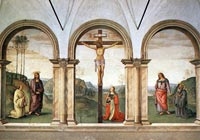 |
||
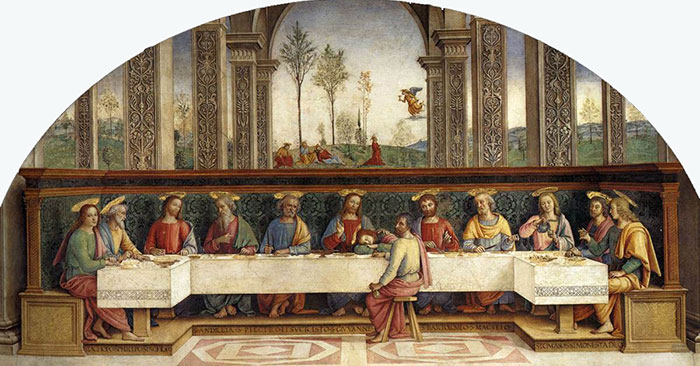 |
|||
Pietro Perugino, The Last Supper, 1493-96, fresco, 440 x 800 cm, Convent of the Tertiary Franciscans, Foligno
|
|||
| The Cenacolo di Foligno is located in the ex-convent of the Tertiary Franciscans of Foligno, transformed into the "Conservatory of poor and honest girls" in 1980 after the transfer of the nuns. Like many churches in Florence, the interior was whitewashed in the 18th century, and this beautiful Perugino fresco was uncovered and rediscovered only in the 19th century. It was initially attributed to Raphael, who was actually Perugino's student. Recent critics have unanimously agreed it was the work of Perugino, dating it between 1493-96. The idea has also been advanced that it was painted over another fresco of the same theme by Neri di Bicci (1419-1491). This work can be regarded as one of the most important examples of Umbrian culture of the Renaissance of which Perugino, Raphaels's master, was one of the most serene and magnificent masters. Art in Tuscany | Last supper frescoes in Florence |
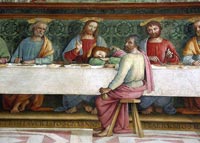 Pietro Perugino, The Last Supper |
||
Pietà |
|||
| Painted for the church of San Giusto . One of the most sober works amongst the numerous paintings of pietistic intent by this master.
The Pietà was executed around 1483-1493, and housed in the Uffizi Gallery, Florence. The work was painted for the church of the convent of San Giusto alle mura, near Florence, together with the Agony in the Garden and a Crucifixion. Giorgio Vasari saw them in side altars of the church of San Giovanni Battista alla Calza, after the original location had been destroyed during the Siege of Florence in 1529. It was moved to the Uffizi in the 20th century. The dating of the work is disputed: it varies from 1482, the year of Perugino's return from Rome, to a slightly later period, although before the end of the century, when the artist started to use only line oil, which in these works is used only at an experimental level. |
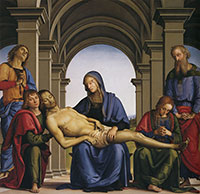 Pietro Perugino, Pietà, Uffizi Gallery, Florence |
||
| Elvio Lunghi, Il Martirio di san Sebastiano di Pietro Perugino a Panicale, Fabrizio Fabbri Editore, 2005 | |
||
|
|||
| Pietro Perugino and the Trasimeno lake scenary |
|||
| A guide to the works of Pietro Perugino in the area, pathways to explore the artistic and cultural heritage of the land of Lake Trasimeno. Renaissance and Mannerism Painting in Città della Pieve-Paciano-Panicale Castiglione del Lago. Read more | Renaissance and Mannerism Painting in Città della Pieve, Paciano, Panicale and Castiglione del Lago Arte in Toscana | Giorgio Vasari, Le vite de' più eccellenti pittori, scultori e architettori (1550) | Pietro Perugino Sistine Chapel Virtual tour | www.vatican.va This page incorporates text from the Encyclopædia Britannica, Eleventh Edition |
|||
|
|||
Podere Santa Pia, located in a spectacular, private and tranquil hillside setting just few minutes drive from the walls of Castiglioncello Bandini, is the ideal choice for those seeking a peaceful, uncontaminated environment. Podere Santa Pia is immersed in the utmost quietness of the Alta Maremma, where total privacy is guaranteed, in a scenic location 50 minutes away from both the sea and the Val d'Orcia National Park. For those seeking a peaceful, uncontaminated environment, yet be just a short drive from some one of Tuscany's most intoxicating cities, Santa Pia is the perfect choice. And the Maremma is renowned for its culinary and wine traditions. Experience the best of Tuscany on day tours to Montalcino, Montepulciano, Scansano and the surreal beauty of the Val D'Orcia, and enjoy wine tastings of the famous Brunello, Montecucco and Montepulciano wines. Meanwhile the Tyrrhenian coast is dotted with seaside resorts and hundreds of restaurants and bars catering for the influx of Italian and foreign tourists during the summer months. Holiday accomodation in Tuscany | Podere Santa Pia | Artist and writer's residency |
||||
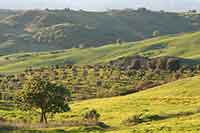 |
||||
Podere Santa Pia |
Pienza |
Century-old olive trees, between Podere Santa Pia and Cinigiano |
||
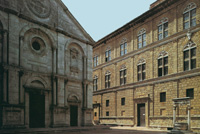 |
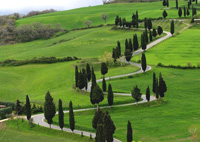 |
|||
Cortona |
Pienza, Piazza Pio II |
Cipress road near Montichiello |
||
 |
||||
Podere Santa Pia offers the most exclusive privacy to enjoy a breathtaking view and have a comfortable, regenerating holiday
|
||||
| Città della Pieve |
||||
| The small town of Città della Pieve, characterized by the red color of bricks with which it was built, is situated on the border of Umbria and Tuscany not far from Lazio, in the heart of Central Italy. It is located on a hill overlooking the Val di Chiana (Chiana Valley) and Lake Trasimeno. Città della Pieve is the birthplace of Perugino who was born there in the middle of the 15th century. Several masterpieces of Perugino are preserved in Città della Pieve: the renowned "Adoration of the Magi" (1504) in the Oratory of Santa Maria dei Bianchi; " Madonna in Glory and Saints" and "Baptism of Christ" in the Cathedral; "Deposition from the Cross" in the church of Santa Maria dei Servi; "Sant'Antonio Abate between Saints Marcello and Paolo Eremita" in the church of San Pietro. In the valley below are Italy's more important communication systems: the regular railroad and the high-speed Florence-Rome railway (the Chiusi- Chianciano Terme station is 8 km away); the A1 highway (Autostrada del Sole) with the Fabro exit 17 km south, and the ChiusiChianciano Terme exit 15 km north of town. Thanks to its favorable position, halfway between Rome and Florence, has known a tourist growth and nowadays is one of the most visited towns of Umbria. Città della Pieve, a typical border town, is an original blend of the cultures of Umbria, Tuscany and Lazio. It belonged to the city-state of Chiusi during the Etruscan-Roman period, as is proven by the numerous archaeological objects, now scattered in various European museums, found along the Val di Chiana at the base of the hill. There remains in Città della Pieve a singular Etruscan obelisk from the 6th century B.C., now on the ground floor of the Palazzo della Corgna. The town developed between the 7th and 8th centuries A.D. around the baptismal church ("Pieve") of Saints Gervasio and Protasio, patrons of the fortified look-out Its urban plan, as we see it today, dates to al least 1250, year of the Emperor's death. It is for these political reasons, and not only for its geographical position, that Castel della Pieve modelled its urban structure and building materials (i.e. bricks) after Siena, the great Central Italian, pro-imperial power in constant conflict with Perugia. Between the 13th and the 14th centuries, numerous buildings rose within the city walls: the new Pieve with early signs of the Gothic style; the Lombard-Romanesque city tower; the Priors' Palace; the Bishop's Tower and the solid Perugia Fortress, built in 1326 by the Sienese architects Lorenzo and Ambrogio Maitani. This is one of the most important examples of military architecture in the region. From the middle of the 14th century, the monastic orders settled outside the city walls and built Sant'Agostino, San Francesco, Santa Maria dei Servi and Santa Lucia. There are numerous paintings by artists of the Sienese School, including the Gothic fresco "Sorrow of the Angels" in the Oratory of San Bartolomeo, painted by Pellicciaio a follower of Pietro Lorenzetti, Ambrogio Lorenzetti and of Simone Martini. Valuable paintings in the Cathedral and in the church of San Francesco are attributed to Perugino's school. Other notable works of art by Salvini and Pomarancio are preserved in the Cathedral and in the church of Sant'Agostino. |
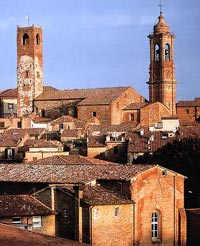 Città della Pieve |
|||
Centro Studi Il Perugino di Citta' della Pieve
|
||||
Bagni San Filippo |
Castiglioncello Bandini |
Rocca d'Orcia |
||

